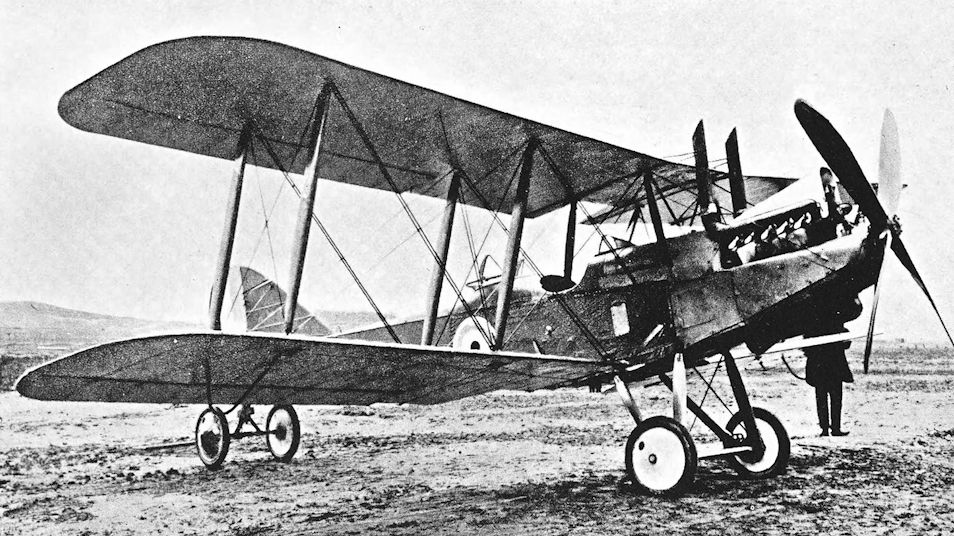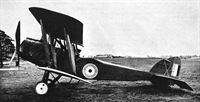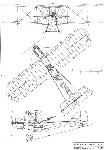P.Hare Royal Aircraft Factory (Putnam)
R.E.9
In mid-1917 a production R.E.8, A4600, had its wings replaced by those from a B.E.2d. Flight trials proved satisfactory and, since this wing structure was stronger than the standard R.E.8 assembly, drawings were prepared for a production version, to be designated the R.E.9.
It may have been the intention of H P Folland, the machine's designer, to settle all the criticism levelled at the R.E.8, for, in addition to its new equal-span, two-bay wings with blunt tips and narrow-chord ailerons hinged from a false rear spar, the new machine was to have an enlarged fin and an aerodynamically balanced rudder. A second machine, A3561, was similarly modified, but had ailerons of slightly shorter span. However, test results showed no advantage in performance over that of the standard R.E.8, the rate of climb being somewhat poorer, and the new design was consequently not adopted for production.
The eventual fate of the two machines is not known, although A3561 was retained at Farnborough as a test bed for some time, and was fitted with various modified control surfaces and also, during 1918, with a 265hp Sunbeam Maori engine.
A broadly similar design, designated the R.T.1, was produced by the Siddeley Deasy Motor Car Company, where both F M Green and J Lloyd had taken up employment after leaving Farnborough. It appears to have been based upon preliminary work previously undertaken at the Royal Aircraft Factory concurrently with the R.E.9 project. The R.T.1 had a modified R.E.8 fuselage, for which type the company was.a contractor, to which were fitted two-bay wings of new design, the upper wing being of greater chord than the lower. Three prototypes were built and tested, but the type was not adopted by the RFC.
Powerplant: 140hp R.A.F.4a V-12
Dimensions:
span 38ft 6in;
chord 6ft 0in;
wing area 382 sq ft;
gap 6ft 3 1/2in;
length 27ft 7in;
height 10ft 5in.
Weight: 2,803lb (loaded).
Performance
ceiling 13,000ft.
J.Bruce British Aeroplanes 1914-1918 (Putnam)
R.E.9
THE R.E.9 was a development of the R.E.8 which appeared in 1917. It had two-bay wings of equal span, and the wing-tips were of the characteristic blunt shape favoured by H. P. Folland. At least two R.E.8s, A.3561 and A.4600, were converted into R.E.9s, but it is uncertain which aircraft came first.
Of the photographs which have survived, those of A.4600 depict the R.E.9 in its true form with the 150 h.p. R.A.F. 4a engine in a standard R.E.8 installation. Doubtless control surfaces underwent modification from time to time, but it will be seen that A.4600 had a horn-balanced rudder, a large fin with straight leading edge, an under-fin reminiscent of that of the S.E.5, and long ailerons which were hinged to false spars a short distance behind the rear main spars of the mainplanes.
The wing area of the R.E.9 was very little greater than that of the R.E.8, and the later design may have been built to provide comparative data for wings of equal and unequal span on the same type of aircraft. Alternatively, it may have been an attempt to produce an aircraft with flight characteristics similar to those of the R.E.8 but with a stronger wing truss. However, the available performance figures for the R.E.g with R.A.F. 4a engine indicate that it was inferior to the R.E.8 in rate of climb at least, and that may be why the design was not developed.
The other R.E.9, A.3561, was flown in 1918 with a 265 h.p. Sunbeam Maori engine. That particular type of engine had been supplied almost exclusively to the Admiralty, and the installation of a specimen in an R.E.9 was probably made solely to determine the power-unit’s capabilities. The Maori was enclosed in a bulky cowling surmounted by a substantial central exhaust stack. Forward view from the cockpit was poor, and it was further impaired by the two radiator blocks. A gravity fuel tank was fitted above the centre-section.
The ailerons of A.3561 were of slightly shorter span than those of A.4600 and had only single control horns. The centre-section bracing was reinforced by the fitting of a diagonal strut between the normal struts on each side, and the fin had a rounded leading edge. There were large cut-outs in the roots of the lower mainplanes to improve the pilot’s downward view.
As first flown by Captain J. Palethorpe in May, 1918, the Maori-powered R.E.9 was catastrophically tail-heavy with engine on and nose-heavy with engine off. But for the presence of mind of Lieutenant W. H. S. Elliott, the flight observer, the machine would probably have crashed. Engine on, he hung shot bags (carried as ballast) round Palethorpe’s neck; engine off, he crawled as far aft as he could down the fuselage, taking the shot bags with him. His prompt action brought the R.E.9 to a condition in which it was just controllable.
In 1919 an R.E. 9 was used in a series of tests to determine the maximum amount of control which could be obtained with elevators of different areas. Four different elevators were fitted successively: they were respectively of 30, 35, 40 and 50 per cent of the total horizontal tail-area, and it was proved that the machine was most manageable with the 35 per cent elevators. For these experiments a sliding weight was installed in the R.E.9. This weight could be moved in flight from the observer’s cockpit to the tail. With the weight fully aft, the aircraft’s centre of gravity was in the correct position; but when it was fully forward the machine became very nose-heavy. The complete sequence of tests were performed by one pilot, Captain J. G. S. Candy; but the R.E.9 was flown with the 35 per cent elevators by Lieutenant R. K. Muir and Captain H. A. Renwick.
SPECIFICATION
Manufacturers: The R.E.9s were converted from R.E.8s built by the Daimler Co., Ltd. (A.3561), and the Standard Motor Co., Ltd. (A.4600).
Power: 150 h.p. R.A.F. 4a. A.3561 was modified to have the 265 h.p. Sunbeam Maori, engine No. 19379. Dimensions: Span: 38 ft 6 in. Length: 27 ft 7 in. Height: 10 ft 5 in. Chord: 5 ft 6 in. Gap: 5 ft 5 in.
Areas: Wings: 382 sq ft.
Weights: Loaded: 2,800 lb.
Performance: (With R.A.F. 4a) Climb to 5,000 ft: 11 min 20 sec; to 10,000 ft: 35 min 40 sec. Ceiling: 13,000 ft. (With Maori on flight dated August 6th, 1918) Climb to 2,500 ft: 2 min 30 sec; to 5,000 ft: 6 min 45 sec; to 6,000 ft: 8 min 30 sec; to 7,000 ft: 10 min 15 sec.
Armament: The R.E.9 could be armed in the same way as the R.E.8.
Serial Numbers: A.3561, A.4600.
H.King Armament of British Aircraft (Putnam)
R.E.9. This R.E.8 development was apparently intended to be armed as the standard version of the earlier aircraft.






